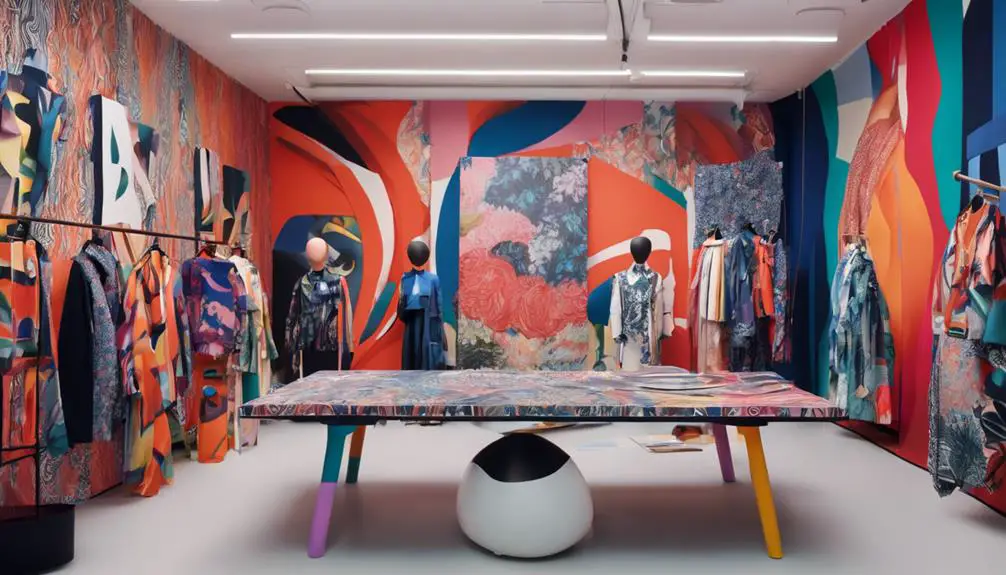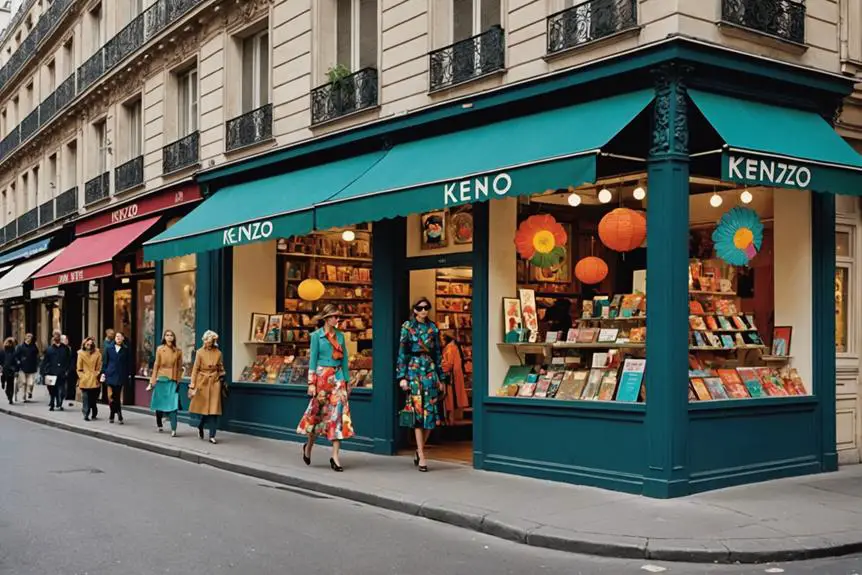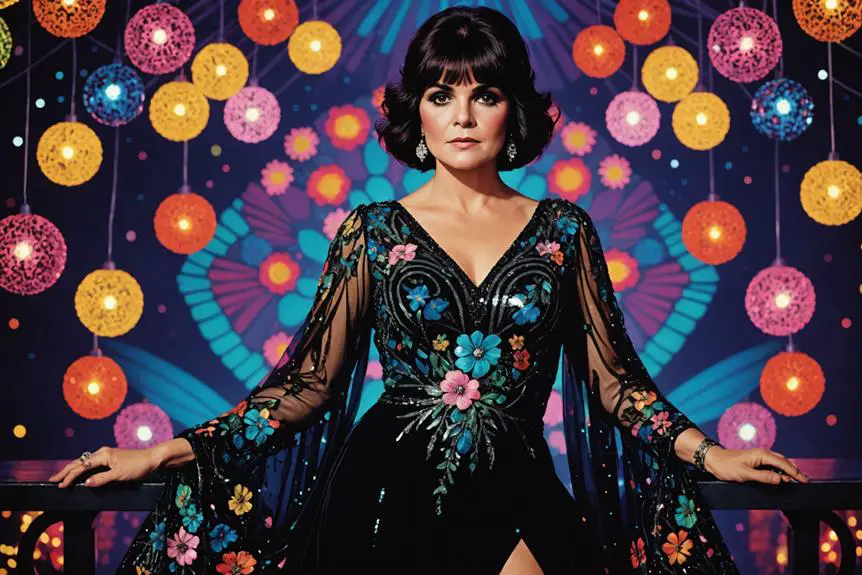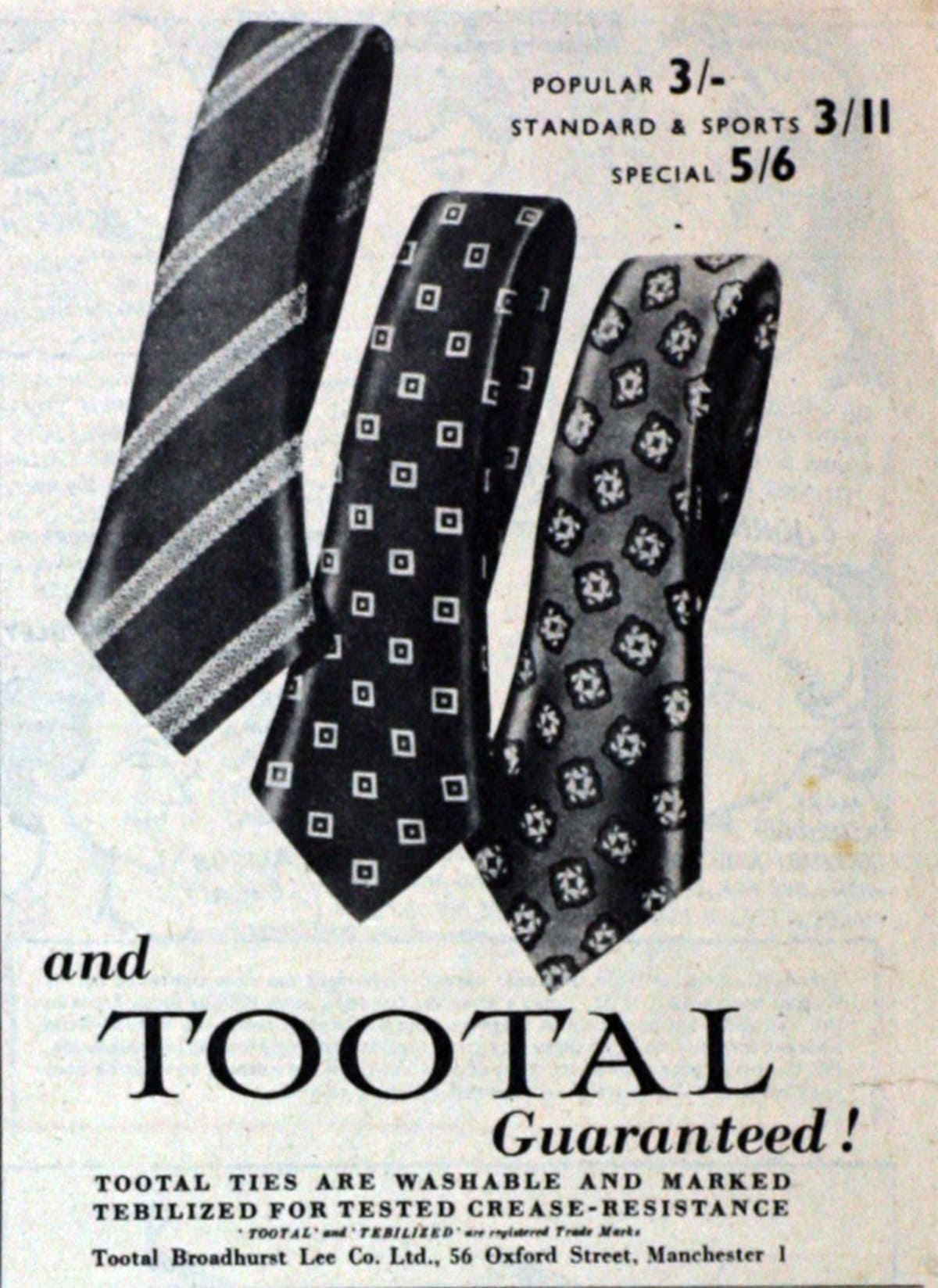Kenzo was founded in 1970 by Kenzo Takada in Paris, where he opened his first boutique, Jungle Jap, in the historic Galerie Vivienne. With just $200 worth of fabrics, Kenzo blended Eastern and Western influences, showcasing his innovative designs. The brand quickly gained attention for its eclectic style and vibrant colors. In 1976, after a successful fashion show in New York, the boutique was officially renamed Kenzo to enhance its global appeal. This fusion of cultures not only shaped Kenzo's identity but also left a lasting impact on the fashion industry, leading to fascinating developments beyond its inception.
The Founder: Kenzo Takada

Kenzo Takada, a visionary in the fashion world, was born on February 27, 1939, in Himeji, Japan. In 1964, he took a bold step by moving to Paris to chase his dreams in fashion. This city, known for its rich artistic heritage, became the perfect backdrop for his innovative ideas.
In 1970, he founded the Kenzo brand by opening his first boutique, Jungle Jap, located in the Galerie Vivienne. This unique name reflected his distinct style and connection to his Japanese roots.
With only $200 worth of fabrics, Takada created his initial collection, which showcased vibrant patterns and silhouettes that blended Eastern and Western influences. His designs quickly gained attention, allowing him to establish a strong presence in the fashion industry.
By 1976, after a successful fashion show in New York, the brand was officially renamed Kenzo, shedding its previous name, which had acquired negative connotations.
In 1993, Kenzo's acquisition by LVMH marked a significant turning point. This partnership allowed the brand to expand globally while ensuring that Takada's artistic legacy remained at the forefront.
His commitment to celebrating the beauty of diversity through fashion continues to resonate today. When you think of Kenzo, you think of bold colors, innovative designs, and a rich cultural heritage—all thanks to the vision of Kenzo Takada, who redefined what it means to be a fashion designer.
Establishment of Kenzo
The establishment of the Kenzo brand in 1970 marked a significant moment in the fashion landscape, as Kenzo Takada brought his unique vision to life in Paris.
Opening his first boutique, Jungle Jap, in the historic Galerie Vivienne, Takada introduced a rejuvenating blend of Eastern and Western aesthetics. His eclectic designs drew heavily from Japanese culture, showcasing a vibrant mix that stood out in the fashion world.
With just $200 worth of fabrics, Kenzo created his initial collection, emphasizing creativity and affordability. This innovative approach quickly caught the attention of fashion enthusiasts and industry insiders alike.
By combining traditional Japanese influences with contemporary styles, he laid the foundation for what would become a lasting fashion legacy.
The evolution of the brand continued when it was officially renamed Kenzo in 1976 after a successful fashion show in New York. This name change allowed the brand to shed negative connotations associated with its original title.
Here are four key points about the establishment of the Kenzo brand:
- Kenzo Takada founded the brand in 1970 in Paris.
- The first boutique, Jungle Jap, opened in the historic Galerie Vivienne.
- Kenzo's initial collection was created from just $200 worth of fabrics.
- The brand gained international recognition for its innovative blend of styles.
Through his unique designs, Kenzo Takada not only created a brand but also solidified his presence and influence in the global fashion industry.
Evolution of the Brand

Evolving from its vibrant roots, Kenzo has continually redefined itself within the fashion landscape. Founded by Kenzo Takada in 1970, the brand started as Jungle Jap in Paris, showcasing colorful, eclectic designs that celebrated Japanese heritage. This unique blend of Eastern and Western aesthetics quickly gained attention, culminating in a successful fashion show in New York in 1976, leading to the brand's official renaming as Kenzo.
Throughout its history, the brand's identity has been shaped by its distinctive logos, reflecting significant phases in fashion culture and the evolution of Kenzo's branding.
In 1993, Kenzo caught the eye of LVMH, the luxury conglomerate that propelled the brand into significant global expansion. Under LVMH's guidance, Kenzo diversified its product lines, introducing fragrances and menswear, which broadened its appeal to a wider audience.
Over the years, the brand has seen various creative directors take the helm, each adding their unique touch to Kenzo's identity. The appointment of Nigo in 2021 marked a pivotal shift, as he infused the brand with streetwear influences, revitalizing its aesthetic while maintaining its core values. This evolution reflects Kenzo's ability to adapt and thrive in an ever-changing fashion world.
Today, Kenzo stands as a symbol of the power of creativity and cultural fusion. Its eclectic designs continue to captivate, drawing inspiration from its rich heritage while embracing contemporary trends.
Whether you're sporting a bold print or a subtle fragrance, you're part of a legacy that celebrates diversity and innovation in fashion.
Impact on Fashion Industry
Few brands have had as profound an impact on the fashion industry as Kenzo. Founded in 1970 by Kenzo Takada, the brand masterfully blended Eastern and Western aesthetics. This innovative approach not only shaped fashion trends but also encouraged a multicultural perspective in luxury goods. You can see the influence of Kenzo in various aspects of the industry today.
Here are four key impacts Kenzo has made:
- Multicultural Approach: Kenzo embraced diverse cultural elements, setting a standard for future designers to follow.
- Kenzo Tiger: The iconic tiger motif symbolizes boldness and artistic expression, becoming a staple in luxury streetwear.
- Celebrity Collaborations: Collaborations like the Kenzo x H&M collection enhanced the brand's visibility and attracted a younger audience to high fashion.
- Creative Direction: Kenzo's unique creative direction paved the way for an explosion of vibrant colors and eclectic prints in fashion.
The brand's acquisition by LVMH in 1993 solidified its position within the competitive luxury market, ensuring that Kenzo continued to influence both established and emerging designers.
By pushing boundaries, Kenzo hasn't only defined its own legacy but has also inspired countless others in the fashion industry.
Today, Kenzo remains a symbol of boldness and creativity, continually shaping trends and challenging norms. Its lasting impact is a reflection of the vision of its founder and the ongoing evolution of luxury fashion.
Current Leadership and Vision

Under the dynamic leadership of CEO Sylvain Blanc, Kenzo is redefining its vision while honoring the brand's rich cultural heritage. Blanc emphasizes brand revitalization, focusing on innovative designs that reflect Kenzo's cultural identity. He aims to expand the brand's global reach, ensuring that Kenzo remains relevant in today's fast-paced fashion industry.
The appointment of Nigo as artistic director in September 2021 has brought a fresh perspective to Kenzo. Nigo, known for his streetwear influence, infuses bold designs into the collections, merging traditional elements with contemporary trends. This creative direction not only celebrates Kenzo's roots but also appeals to a younger audience, making the brand more accessible and exciting.
Sustainability is at the core of Kenzo's current leadership vision. The brand is committed to ethical practices in fashion, aligning with the values of today's consumers who prioritize environmental responsibility. By championing sustainability, Kenzo isn't just keeping up with market trends; it's setting them.
Blanc and his leadership team are dedicated to celebrating nature and cultural diversity through their designs. They believe that fashion should tell a story and reflect the world around us.
With this vision, Kenzo continues to push boundaries, creating innovative designs that resonate with people globally. Together, they're crafting a future that respects the past while boldly stepping into new territories, ensuring Kenzo remains a vibrant player in the fashion landscape.




